#sone examples include
Explore tagged Tumblr posts
Text
I still can’t get over how, of all musical soundtracks, how the THOMAS THE TANK ENGINE SOUNDTRACK, FROM A CHILDREN’S SHOW PRODUCED IN 1983, LITERALLY OBLITERATES ANY AND ALL FORMS OF TV OR FILM SCORES AND JUST CONTINUOUSLY HOTS YOU WITH BANGER AFTER BANGER
#Sorry for yelling#thomas the tank engine#sone examples include#the original 1980s intro theme (especially the full edition)#James the splendid engine#accidents happen now and again#troublesome trucks
3 notes
·
View notes
Text
Surprising absolutely noone except undergraduate math students, it turns out math actually is only about numbers in the end!
#math#mathblr#mathematics#oh so you thought abstract algebra stopped being about numbers to get to more complex structures#and you thought fundamental logic is so abstract exactly because it is more general than just numbers#well guess what#gödel wants to have a word with you#my friend every statement that can possibly be made by humans ever can be made isomorphic to some structure of the natural numbers#even if that structure is a function space of the power set of the power set of the natural numbers#it is possible to write any finite set of axioms as an isomorphism to axioms about the natural numbers#however since the axiomatic definition of the naturals gives you some axioms already it is important to note that for some really fucked up#axiomatic systems you have to explicitly include axioms that prevent you from using thise axioms in sone ways#as in you can't use the set theorethic definition to choose elements of a set for example#you have to choose elements from a set with choice functions constructible from axioms provided#now for making set theory equivalent to the naturals the choice functions you can derive are equivalent to just choosing a natural#but it could be not the case
12 notes
·
View notes
Note
Do you know of any resources or posts specifically about captioning comics? I am very new to this, but I love comics and I make comics so I want to learn how to caption them properly. Thank you for your blog and all you do!
Delighted you asked this, since it gives me the excuse to share one of my top favorite posts about exactly that!!! I used @/TheQueerWithoutFear's addition in this post as a personal bible when starting out with art IDs! I think this post also has advice which is generally applicable to lots of comic IDs, since people can get bogged down writing every single detail of a piece when the broad strokes would do and thus detract from the overall comprehensibility of an ID. I also really appreciate this site as a great resource for examples on how to write concisely and with an audience in mind, and this post also lays out a lot of good tips! I'll round out this post with some general advice/guidelines:
Neither alt text nor caption IDs are better or even necessarily more accessible than the other; what matters is good formatting (so please don't put IDs below a readmore or use anything but plain text, use sentence case and primarily formal language, use brackets and "ID/End ID" formatting for caption IDs but omit them from alt, etc!)
For comics, especially long ones, I personally favor conciseness over strict fidelity to art, though this is highly subjective and depends on the piece and sometimes my mood. What I would boil this down to is that you don't need to include every detail in a piece to write a good ID, and using narration/prose is often more understandable than transcribing visual techniques (Ex: "She notices something to the side" is clearer and more succinct than "Action lines next to her face indicate she saw something to the side")
Organizing an ID's information in a top-down format is best for comprehensibility: start with who/what is featured (and where they're from, if applicable) and what they're doing, and then move on to background, style, and details
Last, you're welcome, and thank YOU so much for reaching out!! Artists like you make the world go round!! Please feel free to reach out if you ever have more questions, and have a wonderful day!!!
#i really hope this helps anon!! godspeed with all your future projects!!! :DDD#i wish this could've been a bit more in-depth and included a tldr but truthfully i am sick and quite tired 😔#that said if you ever have further questions not only my askbox but my dms are open! i'm always happy to answer!#shoutout also to nik peachygos for suggestions on what to say here :)))) ily king#asks#anonymous#accessibility#kay talks#also anon consider checking out my personal id tag on my fandom blog (linked in my bio) for examples of how i personally write comic ids!#ALSO!! the doc in my pinned post has a section dedicated just to resources!! not all will apply but sone surely will!!
57 notes
·
View notes
Note
Mrs. König who cannot stand still when she is anxious, in this case being captive in her own home without doing much change her activities every 5-10 minutes so as not to enter into crisis.
König would accept to buy material/courses to learn another language other than German? This his dear wife will continue to depend on him in that country, and will not enter into a crisis due to boredom.
Konig is willing to buy her the moon if she'd only ask for it! As long as her hobby doesn't require her to constantly be around other people, especially men, he is fine with her getting put if the house for a little bit. Would be more willing if he'd be the one to drive her, since he is too worried about her on her own.
He will expand on his small gym area in the house to include some if the equipment she might want! Sport is a good way of burning energy, and they can be training buddies together!!
He us fine with her getting an online language course for, for example, French or Chinese. He'd pay for individual classes and buy her all books needed. He is proficient in more languages than what you might think – he knows a bit if everything, French, Italian, some if slavic expressions as well, so he'd encourage darling to get as much hobbies as she might want.
He will also take her out whenever he can! To theaters, to parks, to sone dumb movies and nice cozy cafés without a lot of people around, so they both would feel comfortable.
234 notes
·
View notes
Text
youtube
Inouesatoh tweeted a video from the Yanmaga YouTube channel that features footage from the publisher's year-end party. There were many manga artists in attendance, and they were each briefly interviewed during the party. Each one had the chance to choose from one of nine questions that they'd like to answer. Below, some of the examples shown include: what is the most enjoyable part about drawing manga, who is a manga creator you currently like, and what does solitude mean (kind of getting more philosophical on that last one lol, but I suppose it is relevant to manga creators who may often work in isolation when their assistants or editors aren't around. And flipping around to the various artists in the video, a few did choose this question).

Inouesatoh's segment starts around 20:40 into the video if anyone would like to hear her voice and see her (obscured) face.

She chooses the question "what does manga mean to you?"
Inouesatoh: To me, manga is entertainment. It's very important in my life. When I'm feeling down, or going through tough times, manga is what I read to gain the strength to keep moving forward. Manga is also what helps me cry things out and move on when I'm feeling sad. When I'm scared, manga allows me to read something that's even scarier, clear my head, and move on to the next thing. I guess? (laugh).
Interviewer: Have you ever experienced the feeling that a particular manga or character saved your life?
Inouesatoh: Many times, so many that it's hard to think of an example. Oh, but I think I have one. It's a manga that's kind of about gender, about not having to put gender at the forefront, that it's okay to just be yourself. That was a manga I read in elementary school, and I felt like it saved me. It was called "Fushigi no Kuni no Senichiya", it ran in Nakayoshi, by Masako Sone. (Note: from what I can tell, this series never had an official English translation, but would best be titled as something like "1001 Nights in Wonderland". It ran from 1980 to 1985, and featured the adventures of a girl who was born into royalty and raised as a prince.)
Interviewer: By the way, next year...or rather, this year your series is getting a movie adaptation?
Inouesatoh: Yes it is, thanks to everyone's support.
Interviewer: And with Keishi Ootomo directing.
Inouesatoh: Yes, it's really reassuring. He's taking solid, beautiful imagery, and really...how should I put this...and just expanding it out like a treasure. That's what he's doing as a director.
Interviewer: I'm looking forward to the movie.
Inouesatoh: Thank you so much. I'm also looking forward to it.
It's quite rare to see any interviews from her, and even rarer for her to appear on camera, so even though this was quite short, it was nice to listen to her thoughts and see her excitement for the movie. If you'd like even more Inouesatoh in your life, I have a report from a couple years ago from the Real 10 Dance event I attended in Japan, where she revealed many interesting tidbits about the series.
22 notes
·
View notes
Text
Emma: "This is Daniel, the coolest android in the world! Say hi, Daniel!"
Daniel: "Hello!"
Emma: "You're my bestie! We'll always be together!"
The thing is, Emma probably didn't even know anything about her father's plans to replace Daniel, and it is really possible that if she had a chance to get to know about it before Daniel, she'd be the one throwing a tantrum, potentially preventing anything that happened instead. Aside from just Emma, it was repeatedly mentioned throughout the game that kids actually love androids. For example there's this dialogue at the station that Markus can overhear:
Little girl, visibly upset, hugging herself: "Are we really going to get rid of Mandy?"
(Probably mother): "Grandma says it leaves her nothing to do, sweetie."
Little girl: "But she's so cool!"
Mother: "I know, honey."
Not only kids think they're cool, android-only band Here4You is even hitting the charts as one of the most popular among youngsters, whereas adults find them really creepy and soulless. Another overhead dialogue from the same chapter:
"I heard that android boyband is going to win sone music prize"
"You mean Here4You? God, they're so creepy.
"My kids don't listen to anything else."
From adult's POV this attachment is interpreted as just another form of phone/internet/social-media/[insert anything else young people are accused of liking too much]-addiction, because most of them are too angry at CyberLife to comprehend that their kids may actually like androids for who they are as people in their lives, for being their safe space of a kind, and not because they're just addicted to that fancy toys to play with (although there probably are some kids who'd see them exactly this way. There always are.)
It was truly a misfortune that Daniel got so overwhelmed by the news that he instantly became fatalistic instead of pausing to really think about it first, to maybe consider that this decision may not have been a collective one, and there's still a chance -- maybe a small one, but still the one worth looking into -- to cancel it by talking, asking Emma about if she knows (because she probably didn't) instead of instantly going for the gun to take revenge on everyone as equally guilty. Instead of asking, he instantly assumed the worst – that Emma's opinion in the matter will be the same as her father's, and that was his main mistake. Daniel must have had really good relationships with the whole family including the father who as it turned out didn't think of him as a person, but rather a replaceable object – something Daniel never expected or even considered before, which, by the way, only further implies just how much he was actually loved for this information to be this unexpected and this world-shattering. He never saw it coming AT ALL (and in a generally anti-android society it really is telling) so this unexpected truth basically overwritten everything he ever knew about his life and world as a whole, making him feel like a fool for not seeing it earlier.
In this sense he's really similar to Connor when he realised that CyberLife never loved him, that he in fact is NOT special, not an exception from the rule, and was only used as an expendable object. There really is a parallel here. Except for Connor this knowledge didn't came with an anger, but with guilt for his previous actions (and, you know, Connor was actually right about it while Daniel could have potentially made a mistake in interpreting it the way he did)
So "Daniel never saw it coming because he was only surrounded by love" is one theory, but now I wanna consider a different one, being –
He was never going to be replaced on the first place,
Philips family is just insanely rich and John decided that he can afford to buy one more android, because why not? The one they have is great, and their enormous apartment with giant gold statues of Buddha and big-ass pool area would benefit from another pair of hands. It's possible that this decision wasn't even planned, but just an impulsive purchase done by someone who's so rich that spending nearly 10K is not a big deal.
And in this case, maybe Daniel's suspicion accumulated over a period time of him hearing how other androids are talked about outside of Philip's family and always thinking "For me it's different – they actually love me for who I am and will never replace like that. They're not like those other people, they're different, I'm different." And then him seeing that purchase was just...the last straw that was needed for him to apply all those previous already existing suspicions to his own situation and finally consider that they might actually apply to him, resulting in him drawing those depressing conclusions that if true would mean that his whole life has been a lie that he was just too stupid to be able to see through.
So there's at least a small chance that it was all a result of just a big misjudgement and/or could be avoided if dialogue was Daniel's first choice of action instead of him getting blinded by his anger and urge to take revenge on those who -- at least from his immediate understanding of the situation -- betrayed him.
188 notes
·
View notes
Text
Writing Theory: A Great Opening Chapter

The first step a reader takes into your story & world is through the opening chapter of the novel. Opening chapters are the writer's way of introducing their characters, plot and world to a stranger: just as important as a handshake at an interview. Thank you to @curiousloveable
What makes a First Chapter Pop for a Reader?
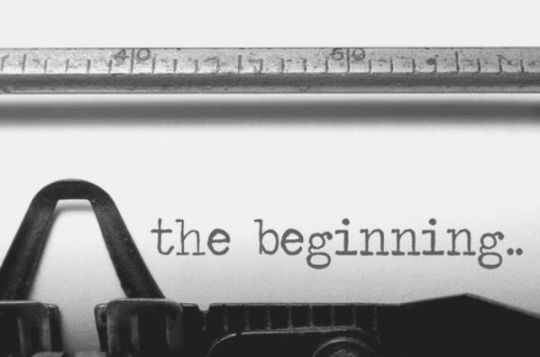
Some readers are fickle and will abandon books without an interesting first chapter. Some power through and discover the story beyond. But you cannot go into writing the opening chapter thinking such. First Chapters are your way of introducing your story to a stranger. You want to make the right impression, put your reader in the right mood.
As a reader myself, the most entertaining opening chapters are those that are not bogged down by expostion and terrible character descriptions. They are the ones that tell you where you are, what you're doing and who is leading you through the story. Your opening chapter should be concise and to the point. Your reader doesn't care whether your character has eyelashes that smwould shame a cow or likes to butter their toast sideways. It's not important yet unless your bovine MC is going to survive the opening act of the plot because they butter their toast lift to right.
Kinds of Opening Chapter

There are 3 kinds of opening chapter, which I have given sone helpful names:
The Jump Into it: The jump into it is basically an action-packed chapter. The reader comes upon the characters in the thick of the story. This kind of chapter has a great hook as it immediately plants the reader in the middle of things with no explanations. These chapters are usually very effective but can alienate readers who prefer a more structured story slope. The example here is the opening chapter of Maze Runner by James Dashner. Thomas is in the lift about to be delivered to the Glade. We experience first hand his fear, his confusion and the world from his Pov which is a pretty clever truck as we begin life at the Glade just like Thomas.
The Gentle Slope: This chapter begins the story off at a slow or middling pace in order to ease your reader into it. These chapters usually show the character's life before it goes to shit. Readers learn about the world and get to know their narrator. Our example is the The Hunger Games by Suzanne Collins. We are introduced to Katniss and her life, we hear about her family and the eponymous Hunger Games.
The Skew: This chapter dies not focus on the main protagonist, instead focusing on another character or storyline, associated but not connected to the MC. These chapters place your character into the world and basically lay the foundations of what your story will become. These chapters are mainly written to provide ground for the rest of your story to stand on. In A Game of Thrones, the book opens with a chapter focusing on the Wights or White Walkers and the Night's Watch who have stumbled upon them. We learn about the Night's Watch, the threats they face and are introduced to the main antagonist of the series. The same can be said of Harry Potter & the Philosopher's Stone. We are introduced to the Dursleys, to Dumbledore and to Harry. We hear about Harry and the events that orphaned him and will echo throughout the series.
What should be included in an Opening Chapter?
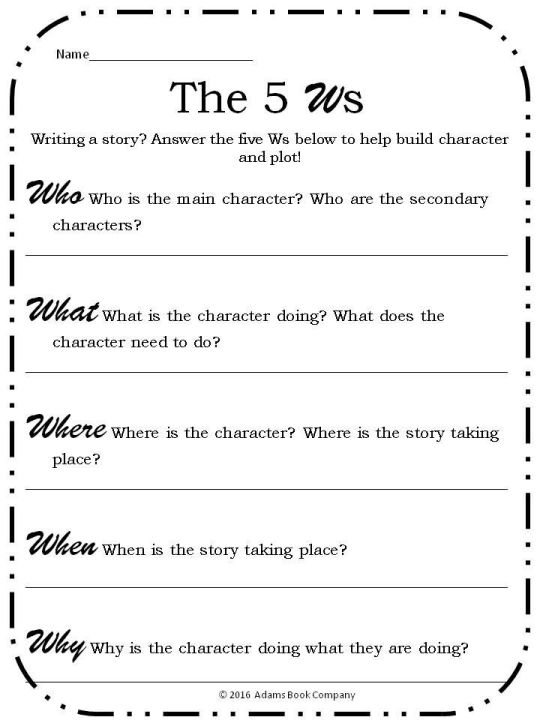
As I said, the opening chapter is the introduction to the story. An opening chapter should have the most fundamental things a reader should know about your story & the narrator.
Firstly, the fundamental:
1) Who is the Narrator?
2) Where are we?
3) What's happening in your narrator's life? / Around them?
The Optional/Subject to story type:
1) introduce antagonist or conflict
2) inciting event to rest of plot
Some things you should remember

Your first draft doesn't matter. You can akways go back to fix it. Think of it like a stepstool in front of a ledge, you need to stand on it to get where you're going. Don't sweat it. You can beat yourself up about it after.
Your characters should not push their luck with the reader yet. Your character is a stranger and your OC needs to make an impression. Throw out the "I'm not like other girls" or the "I'm the baddest boy on this block". Your reader doesn't have time for this yet.
Make your reader love your OC or at least relate with them. Your OC is your reader's guide in this world, they must relate or like them at least a little bit. It will cast your OC into dull lights for your reader and may poison the plot.
Don't overwhelm your readers with jargon yet. Give them the most fundamental facts about the world as they need. Think of it like this: your reader needs to know they are on Earth but they do not yet need to know about the Big Bang created it all.
#Writing Theory#writing#Opening Chapter#How to Write an Opening Chapter#writing resources#writing reference#writeblr#writing advice#writer#writer's problems#spilled words#characters#writer's life#Writers guide#writing help#Writing tips#Writing advice writing reference#Writing Resources writing references#Writing reference writing Resources
3K notes
·
View notes
Note
HI I HAVE LIKE SO MANY XIAO BRAINROTS BC OF ME RECENTLY GETTING BIM SO HERE HAVE ONE OF MG DYNASTY AUS (i also posted another brainrot of him on mu page)
Perhaps during the archon war, as reader and the other yakshas were fighting different monsters , a mysterious portal had appeared sucking in the yakshas including reader teleporting them to our modern times but strangely enough they popped in at different timings (ex. 2013, 2016 etc) .
All of the yakshas memories of each other were gone but each of them kept of receiving dreams of their past life when in the dynasty era (courtesy of a certain dendro archon) , though all of them first pass it off as a dream they can't deny it made them slightly freak out with how familiar fighting was.
Of course, reader and yakshas met when they entered college. As the group finally reunites, would they be able to find out who really is the mastermind behind all of this?
Would Xiao and Reader finally confess their love for each other or would they fail to do that just like in their previous era?
Small holes in the story bc im still tryna figure sone things out 😭

this is a cool idea because it has so much potential for found family dynamics and deja vu between the characters; for example, somehow knowing their names despite never having met them before, recognising their face, being able to talk to each other like they’ve known each other for years…
and regarding xiao and the reader, no doubt it’s a sort of love-at-first-sight-but-i’m-sure-we’ve-met-somewhere-before interaction… like, you lock eyes randomly while passing through a hallway and both do a double take.
good things about being in the modern day is that the yakshas don’t have to worry about their karmic debt anymore, or days full of slaughter and bloody battle. however, everyone does get nightmares. graphic nightmares about being in a body that’s their own but not quite, and holding weapons and channelling magic that could never exist in real life but feel so right in their hands. soon after, they start sharing dreams, and find their classmates fighting alongside them. it’s probably these dreams that bring them together.
as disturbing as these nightmares may be, because they’re not real, it does mean that pursuing certain things— namely romance, in your and xiao’s cases— is much easier when you don’t have to worry about the other dying at any given moment. you probably skirt around each other for a while, both drawn in and put off by the familiarity you feel when around each other, but slowly allow yourselves to indulge in your feelings more and more…
also… modern au!xiao. i love him.
#sent: astrididi#r answers#i’m also imagining an au which is like… tgcf or mdzs style?#so like… fantasy ancient china basically because can you imagine how good xiao would look with long hair and those flowy robes—#with gods and/or cultivation being a centre point of the story
5 notes
·
View notes
Text
TW: mentioning of hate, death threats, tandere behaviour and opinions on that subject, proceed with caution.
I've been seeing a few yandere bts writers getting hate, because they write about bts as yanderes. I thankfully haven't been one of the people who got any hate, but I still disagree with these people getting hate. Especially when the hate is something like; "kill yourself", "slit your wrists and bleed out" or any form of insults thrown at them. Encouraging someone to commit suicide is absolutely disgusting. Especially when you're too cowardly and comment such things as an anon. I understand that the yandere genre is very controversial because of it's brutal and psychotic nature. However, I thought I would explain why I chose to write about yandere bts. This is not something everyone else agrees with, but it's my personal reasoning. Perhaps it'll move some to view this community with less hate.
First of all, something you always hear, I do not condone any actions of my yandere characters in real life. I am also not trying to romanticise stalker-, obsessive- or abusive behaviour. The appeal of many yandere characters is how far in their own twisted understanding of love they are trapped, to the point of not realising how toxic, creepy and downright insane their actions are. The appeal of yanderes is their psychotic behaviour, because it's so absurd that they do not realise the affect their actions have, or misinterpret that affect. Killing, torture or stalking is another way of pushing that detachment from morality and common sense. This is not something I wish upon anyone and purely a fictional scenario. Just like any villian in any story, these traits and actions are used to make them stand out, seem heartless, insane and/or interesting. It's part of the fictional story people are telling. Just because you yourself don't like their story, doesn't mean you get to send them such brutal hate messages.
Another thing many people criticise, is the use of real people in these stories (specifically in × reader stories). I feel that I am speaking for most writers when I say, that we do not view bts or any other celebrity, youtuber etc. as such psychopaths. The changing if the character is due to that exact reasoning. I do not want to make them act like their usual self if I'm also going to have them kill, torture, stalk, threaten or commit any crimes. I personally respect bts, as well as any other celebrity out there, a lot and do not wish to portray them in a bad light. In case you have criticism about a certain behaviour of one of them, I am always open for constructive criticism and advice. However, if I respond that their behaviour has a reason, then I will not change that character. But any criticism will flow into a writers writing and way of portraying the characters, so it's not completely fruitless.
The personal reasoning of mine, as to why I use kpop groups and write about them as yanderes, might not relate with everyone. So take the following bit with a grain of salt. As I've mentioned earlier, I find the stories you can create with yandere characters fascinating. While the usual sweet romance that many fanfiction writers tend to write about is very nice and sweet, it can sometimes be uninteresting to me. This has nothing to do with the quality of the writing or the writer themselves, but just because I've seen it so much already. While yandere fanfictions aren't totally unique as well, each writer somehow has a different way of portraying their characters. Some go for a darker approach (example: @chinkbihh) and others prefer to involve humor in their stories (example: @babeejk). Both are very good writers with many pieces that I've adored. The characters don't have to always portrayed as perfect and morally good, they can have severe flaws that make them unappealing as a partner. When we take axlook at my characters, Yoongi is a pushover, Seokjin is arrogant, Taehyung doesn't have a mind of his own and Jeongguk has anger issues. All have flaws that make their character interesting in sone sort of way.
I myself prefer to write the yanderes as more obsessive and obedient to the reader (Y/n). The reason for that is, that I want my readers to feel appreciated while reading. Yandere behaviour in reality is dark, scary and absolutely terrifying, but within the realms of fiction it can turn into something flattering or comforting. The idea of a person loving you so much that they would do literally everything for you, is compelling to many (including myself). Especially people like me, who grew up without much attention, friends and felt left alone, reading such stories can be comforting. The fact that it's a familiar person, someone you admire and love, adds unto the feeling. No, this does not mean I (or anyone else) would ever like someone to treat us like that in real life. But the idea of a yandere, a person who adores you more than we can fathom, is compelling for people who feel lonely. Yandere stories can be a way of comfort, they can help people motivate themselves and make them happy. For that reason alone, I believe it is totally valid to both write and read yandere stories.
And to all those who think writing hate comments, death threats or suicide encouragement to writers is reasonable, you are such a disgusting person! No one is forcing you to read these stories, if you don't like them, block their account or ignore their posts. But don't ever send hate! Especially those who hate on × reader stories specifically. × reader stories don't just entertain delusional fangirls, that is an overused stereotype.
Please stay respectful towards everyone. You are allowed to agree and disagree with people, but hating on someone goes too far.
❤❤🍑
85 notes
·
View notes
Photo

**Please do not repost without credit** [TRANS] 2020.02.26 SONE NOTE LIVE vol. 26 with Taeyeon
Staff: You tried making herb soap this time! How was it?
Taeyeon: It was really fun! It was very enjoyable as there were many scents and colorful materials that I liked. I was able to bring Zero as well so it was even more fun (laughs).
Staff: Do you usually fragrance your room, wear perfume, or have a preference on how you enjoy scents?
Taeyeon: I’m actually an aroma enthusiast (laughs). It’s not that I’m sensitive to smells, but I’m really interested in things related to scents. So I love perfumes and aroma oils! I usually mix massage oils with aroma oils and do home care, and also add aroma oils when I take half body baths.
At home, I add a few drops of aroma oil to a hot towel and warm my face with it. It’s good for removing keratin. And above all, it’s the best for relaxing!
Staff: It seems you really like fragrances, but have you ever given them as presents?
Taeyeon: Scents can be separated into likes and dislikes. A scent that I like might not be liked by the other person, so I don’t really choose them as presents. However, the soaps I made today might be good gifts! They look cute and I think people would be very happy to receive them!
Staff: Do you have a preference when it comes to perfumes?
Taeyeon: For perfumes that I received as presents, scents that I don’t really like, or when choosing scents for their effect, I mix them with other scents!
Staff: What fragrances do you not like?
Taeyeon: I don’t really like ylang-ylang. It’s effect can calm you down and it is a great herb, but the scent is very peculiar and I don’t feel good if I breathe in a lot of it. So if I receive a fragrance that has ylang-ylang, I use it by mixing in a lot of another scent. I decide the ratio of the mixture each time!
Staff: You carefully smelled each fragrance while making the soaps.
Taeyeon: When I do that, I pretty much know how to proportion the scents. Of course, that’s just my intuition (laughs).
Staff: What scents do you like?
Taeyeon: I like peppermint. I like herb aromas that are good for reducing stress and are relaxing like peppermint. When I want to relax, I add peppermint oil to the bathtub and take a bath. It’s too bad there was no peppermint in today’s materials (laughs). However, I believe scents that will go well with soaps are different from the scents that I like.
Staff: On what occasions do you want to smell fragrances?
Taeyeon: Aroma scents have different effects, so I use aroma oils based on what would suit my condition, the effect, and for day or night. For nighttime, I like peppermint and orange scents to relax, and also tea tree and rosemary. Rosemary especially seems good for ladies. It seems like it’s good for feminine symptoms! I know a lot of miscellaneous knowledge (laughs). Personally, I’m interested in and really like aroma herbs so I usually look up various information online and listen to therapists’ talks. Ah, and lemon is good for the daytime! It has a refreshing effect!
Staff: Does Zero also like scents?
Taeyeon: Apparently, aroma oils also have a good effect for dogs. So when I give Zero a massage, I lightly add some aroma oils and massage his neck. I really recommend it! His neck is always stiff so I usually massage it with lavender oil, which relaxes muscles. Some dogs don’t like fragrances, but Zero loves it and is very obedient during massages (laughs).
Staff: You made herb soap this time, but do you usually use them?
Taeyeon: I’ve used commercial herb soaps before, but this is the first time I tried using homemade ones. I don’t usually use solid soap and instead often use liquid soap, but the point of choosing a soap is the scent! A nice scent that remains after rinsing is great.
The types of soaps I have at home are balsamic? There’s a lot that are woody but refreshing, like a pinecone for example (laughs). When I smell those scents, I feel clean and purified, and I feel really good!
Staff: What are your thoughts on making herb soap?
Taeyeon: It was easier than I thought! It was easy, interesting, and fun… You can enjoy making them even if it is your first time!
Staff: Was there any part that was especially difficult?
Taeyeon: Probably the weight measurements? I had to make fine adjustments. The measurements were in units of 0.1, so I couldn’t boldly add a lot in. When making the first soap, I did not grasp that feeling at all and added all the oil and coloring at once, so I overloaded the scale (laughs).
Staff: What was the most enjoyable step?
Taeyeon: It was fun to add the various toppings, but pouring the soap base into the mold was the most fun! How can I say it… there was a kind of soft feeling how the mold slowly filled in? It’s probably a strange feeling of accomplishment (laughs). What am I, feeling a sense of achievement at a step where the soap isn’t even finished yet. (laughs)
Staff: You made several types of soap today, but please share the concept for the soap being given to SONE JAPAN.
Taeyeon: I wanted to make it different from other transparent soaps, so I added a milky color! So it has a slightly mild image for the design. Also, I wanted it to have a clean and calm scent, so I added rosemary aroma oil. Since it is a present for SONE, I had to make it pink! The toppings were to complement the pink so I chose purple and blues! Honestly, I think I made it pretty cute♪
Staff: For the toppings, what was your overall preference?
Taeyeon: That would be making a visual point. I wanted to always have a point one way or another. Have one thing be a different color, or on the other hand, have everything be the same color as the point… I decorated them with that kind of thinking.
Also, I topped them off with things that would suit each scent! For example, for the orange oil soap, I placed yellow and red toppings, for the tea tree oil soap, I used herb leaves!
Staff: Which soap are you the most pleased with? Please also share why.
Taeyeon: I really liked the orange soap, which I actually tried washing my hands with, and the mint soap that I made last! The reason why I like the mint soap is simply because the level of completion was the highest (laughs). Ah~ It’s perfect (laughs). The topping placement is also perfect, and it’s great that the flowers are neatly placed. So I want to bring the mint soap back home with me! I got better and better from the first soap that I made, so the mint soap that I made last was the best!
So the reason why I like the orange soap is because I personally like the design. Dried oranges were included as the focal point, it is transparent, and feels pure… I tried washing my hands with it a little while ago and the orange scent is still lingering. It’s very refreshing and feels good! It lathers well so it has great cleaning power (laughs).
Staff: What kind of image did you have for the wrapping?
Taeyeon: It was fun and my first time using this kind of wrapping! I wrapped the red soap with a pink paper cushion. Then for the pink soap, I wanted to have a simple wrapping, but it was actually difficult. Tying the ribbon also kind of felt like a puzzle (laughs).
Staff: If you were to give one as a present, who would you give it to? Please share why.
Taeyeon: I want to give the lavender soap to my parents as it has a stress reducing effect and is good for relaxation. Also, I want to give the refreshing citrus and orange soap, and the energy giving lemon soap to the members!
Staff: Among the members, who would be the happiest to receive soap?
Taeyeon: Everyone uses only liquid soap… I wonder if they’d be happy. (laughs). Ah, but I feel like Yoona would be very happy to receive a mixed soap of peppermint and rosemary! I don’t know what scents she usually likes, but this is my intuition (laughs).
Staff: If you had the chance to make herbal soaps with one of the members, who would you make them with? Please share the reason why as well.
Taeyeon: I guess Hyoyeon? She is very original and I feel like she can make them well! I also think she would not use dried flowers as toppings, but instead something very unique. Something like Lego blocks? (laughs) I believe she will make something cute and original. While making the soaps, I also thought of using something more interesting than dried flowers. Using nail parts for toppings would definitely be interesting! Also, it might be hard to use, but a plastic bear would absolutely be cute as a topping (laughs)
Staff: Besides making soap, is there something you want to try with the members?
Taeyeon: Baking! I want to bake! It requires time, but it is the best for feeling that sense of accomplishment. I haven’t done it in a while, so I want to try it again ^^
Staff: You have announced your solo album in Korea, and you were also the official cover artist for singing the Korean version of “Into the Unknown” for the movie “Frozen 2”, but please share your recent activities.
Taeyeon: I felt that this song was harder than the previous song, “Let it go”. I just thought of Elsa while singing it. The lyrics are very positive and about going to a new, unknown world, so I sang it while imagining Elsa’s feelings of determination.
Also, I had last year’s hall tour in Japan, solo fan meetings in Osaka and Yokohama, and before that I was always working on my album… I feel like I just kept singing in 2019!
Staff: How was the fan meeting you had in Japan in November last year? Were there any memorable episodes?
Taeyeon: Actually, I really wanted to talk to everyone a lot, but I concentrated too much on making the herbariums and Christmas cards (laughs) I thought that I didn’t really express my feelings well to everyone… I think next time it’d be great if I could have an event to get even closer to everyone!
Staff: This SONE NOTE LIVE will be released in February. Winter will soon end, but please share if you have a favorite way of spending the winter, or winter memories or episodes.
Taeyeon: First, I spread an electric blanket in my bed and turn it ON. Then I wear light clothing, turn the heater off and let the room get cold. It feels so nice to get into bed when only the bed is warm! That is the most enjoyable thing about winter. I watch movies and eat mandarin oranges like that. The bed is an area only for me. The inside of the bed is too comfortable that there’s a saying in Korean of “it’s dangerous outside of the bed!”, and that’s exactly what happens (laughs). This is my only way to spend winter comfortably and warmly!
Also, I always have a Christmas tree in my home 365 days out of the year. I love the tree and have it out even though it’s not related to summer, but once I turn on the cute mood lamp I enjoy it all year round! Even now the tree’s lamp is on at home (laughs). Speaking of which, I received a Frozen ornament as a present, so I will decorate and update my home’s tree after a year. (laughs) It is very cute♪
Staff: Please share what you would like to try in the next SONE NOTE LIVE.
Taeyeon: What haven’t I tried yet… Driving? (laughs) Or a part time job?
Staff: A part time job??
Taeyeon: Yes. I want to work part time at an ice cream stand (laughs). Actually, I always admired part time jobs since I’ve never had one. Of course, I think those actually working on site have a very tough job, but it’s a world that I don’t know so I have a yearning for it. I want to try it out once. I want to scoop up ice cream and give it to customers, and secretly try out the flavors… (laughs) I’d like to try a part time job at a cafe, too. I want to try a lot of different jobs! Ah, a manager experience might be good as well! (laughs)
Staff: Finally, a message for SONE JAPAN please!
Taeyeon: When this interview is released it’ll already be 2020. I hope that everyone does even better than last year! Also, it’d be great to see you all more frequently! I love you~♥ Translation by RedSunsetXIII source: SONE JAPAN website **Please do not repost without credit**
11 notes
·
View notes
Text
EXHAUST FAN

Step by step instructions to Choose the Best Exhaust Fan - Your house is your shelter: subsequent to facing the world and its toxins and aggravations throughout the day, you return and take a full breath to unwind. However, what are you taking in? Lamentably, your house isn't absolved from toxins, allergens, or aggravations. To assist you with breathing simpler, a fumes fan is an unquestionable requirement have, particularly for the present current hermetically sealed homes.
Fumes fans help ventilate your home and make a more beneficial, cleaner indoor condition. In rooms that see a great deal of steam and warmth, for example, the kitchen and washroom, fans are fundamental in shielding mold and buildup from developing, and they are helpful in the remainder of the home for disposing of VOCs (unpredictable natural mixes), which are gases delivered from normal family unit things, for example, building materials, furniture, and rugs. You will most likely be unable to control the air outside, however you can ensure the air inside is sheltered, clean, and breathable.
Picking the Best Exhaust Fan for Your Home - At the least, a fumes fan ought to be introduced in the kitchen and washroom. You can either pick singular fumes fans for these rooms or attempt an entire house exhaust fan. Which is directly for you?
Entire House Fans - An entire house exhaust fan has various advantages, however boss among them is that they can be utilized instead of forced air systems around evening time. The fan will supplant the hot inside air with the cooler air from outside. This reduces your vitality expenses and renews the air. It sounds great, yet entire house fans do have downsides and are not appropriate for each home. So who should stay away?
*People who live in dusty or contaminated conditions.
*Those with hypersensitivities.
*People who live in muggy zones. The entire house fan will attract mugginess, causing your home to feel hotter in the mid year.
*Those with water/air proof homes. While these homes are exceptionally productive, an entire house fan can make a wonder called fiery surge. On the off chance that there isn't sufficient substitution air in the home (regardless of whether on the grounds that insufficient windows are open or in light of the fact that the house simply isn't drafty!), the fan draws air from the main source left - your heater. It draws the fumes from your stack, which presents a carbon monoxide threat. In the event that you do pick an entire house fan, ensure you are providing sufficient substitution air and that you have carbon monoxide identifiers. The TPI Whole House Attic Fan is a decent one to look at for $380.
Kitchen and Bathroom Exhaust Fans - Choosing the correct size washroom and kitchen exhaust fans is basic so you have the air ventilation you need. The Home Ventilating Institute has least suggestions for how frequently the air in a particular room must be supplanted every hour. For a kitchen, it is in any event 15 Air Changes for each Hour (ACH); for a restroom, it is at any rate 8 ACH; and for different rooms, it is at any rate 6 ACH. Let's assume you have to ventilate your washroom and you realize you need at any rate 8 ACH.
The following stage is to compute the cubic feet of the room. In the event that your room is 6 x 10 x 8, you have 480 cubic feet of room. The fumes fan should circle 480 cubic feet of air to rise to 1 ACH. Since you need at any rate 8 ACH, increase 480 x 8. This is 3840 cubic feet for each hour that the fan needs to circle. At the point when you buy your fumes fan, you will see a CFM rating. This is the cubic feet every moment that the fumes fan can cycle. For our example washroom, the CFM is 3840 partitioned by 60, or 64. 64 is the base CFM to search for in a fan for our example restroom.
In the event that you have a carport that you work in oftentimes or which is connected to your home, a decent fumes fan is an unquestionable requirement. Without one, your carport will feel sweltering and stodgy in the late spring, and it will likewise essentially diminish indoor air quality by presenting vehicle exhaust - brimming with poisons and cancer-causing agents - into the home. Attempt the Garage Through the Wall Ventilation Fan, accessible for about $315 from RE Williams Contractors, Inc.
This divider exhaust fan vents poisonous vapor and highlights calm activity, through-the-divider establishment, inherent fiery surge damper, and 416 CFM. It is an extraordinary thought to wire your fumes fan to a clock or to your carport entryway opener and set it to run for around 15 minutes after your vehicle enters or leaves the carport to discard unsafe exhaust. You can peruse the top rated restroom fans here.
Since having a dependable fumes fan is basic, it is suggested that you purchase as well as can be expected bear. One name that you will reliably observe on "Best of" records is Panasonic. Their kitchen and shower exhaust fans are by and large viewed as the absolute best in the business and one of the most mainstream with purchasers. Their Panasonic FV-11VQ5 WhisperCeiling 110 CFM Ceiling Mounted Fan was picked by Buzzillion commentators as the main decision.
This fumes fan includes low commotion, vitality star rating, HVI (Home Ventilating Institute) accreditation, UL posting, rating for ceaseless use, warm cut-off breakers, rust-confirmation lodging, excited steel body, fiery surge forestalling damper, and 110 CFM. The FV-11VQ3 is adulated for its tranquil activity and effective ventilating capacity. This Panasonic records for $225, however you can discover it for as low as $125 online.
The Broan L400K 406 CFM High Capacity Ventilation Ceiling Fan is a decent decision for bigger rooms or kitchens. It highlights 406 CFM flat, 399 CFM vertical, 3.3 sones, 2 metal divergent blower wheels, lacquer steel barbecue, programmed fiery surge dampers, and roof mounts. (Note: "sones" is the apparent tumult. At 3.3, this is a moderately boisterous fan, contrasted with those with 0.3 or 0.5 sone washroom exhaust fans. Remember that this Broan is made for all the more uncompromising applications, so the sones will be more prominent.) The Broan L400K is about $260. names Panasonic, GE, FanTech, and Broan-NuTone as the top brands; pick as well as can be expected for your home. Look at top of the line exhaust fans here.
Since ventilation is so imperative, you might need to consider employing a temporary worker to introduce your fumes fans. As per DIYorNot, the normal expense for somebody introducing his own fumes fan is $100 and 8 hours of work. An expert will cost about $290, with 5 hours of work. This is a public normal, so the real rate will change as per where you live. Choose if the additional cash is worth expert establishment and a few hours of your time.
You could return home from work to think that its all done, or you could dedicate a Saturday to it. Ventilating your home appropriately is perhaps the best thing that you can do to guarantee the wellbeing of those inside and abstain from making a "debilitated house." The best fumes fans from top brands like Broan-NuTone and Panasonic can help make your home the spotless shelter it ought to be..
1 note
·
View note
Text
TAFSIR: Risale-i Nur: The Words Collection:The Thirty Second Word .Part 7
Given this, each living being’s cells, corpuscles, limbs, and nerves are under His command, at His disposal, and move according to His laws. Since this is so, all particles or atoms, the essential building blocks consti-tuting all creatures and their parts as well as being the means for their design and formation, are in His Power’s grasp and His Knowledge’s sphere. They move most regularly and perform perfect duties by His command, per-mission, and strength.
Since every atom moves and functions by His law, permission, and command, then most certainly, it is His Knowledge and Wisdom that dis-tinguish each face by making it unique, their sounds and tongues differ. Consider this verse that, in mentioning only the first and most universal link and the last and most individualized one, points to this chain of cre-ation and the series of His signs in creation: Among His signs is the creation of the heavens and the earth, and the variety of your languages and colors. Indeed, in this are signs for those who know (30:22).
Now we say: “O representative of those associating partners with God! These evidences are as strong as the chains of creation, which point to an Absolutely Powerful One and prove His Unity.”
Since the creation of the heavens and the earth shows an All-Powerful Maker and His boundless and infinitely perfect Power, certainly, He is absolutely independent of partners. While He has no need for them, why do you follow the dark way of associating partners with Him? As He has no partners in His Divinity, any partnership in His Lordship and creativity is impossible. The Power of the Maker of the universe and the earth is bound-less and infinitely perfect, and everything is equal before It. If there were a partner, this would require that a limited power defeat a boundless and infi-nitely perfect power, or somehow limit it and infect it with incapacity. Such assertions are completely untenable.
There is no need for partners, and their supposed existence is incon-ceivable. Therefore, claiming partnership is no more than forced and arbi-trary judgments that cannot be substantiated by reason or logic. It is a prin-ciple of theology and methodology that any probability or possibility not arising from evidence cannot be considered, and that it does not injure conviction or certainty based on knowledge. For example, it is theoretical-ly conceivable that Lake Eðridir might change into oil or grape juice or a heavy syrup. But since this is a mere possibility raised on the basis of no cir-cumstantial evidence, it does not harm our certainty that the lake is water.
Similarly, we have asked each part of the universe: from atoms to stars in the First Station, and from the creation of the heavens and the earth to the variety of tongues and uniquely identification of each face in the Second Station. Each part testified to God’s Oneness and shows the stamp of His Unity. Therefore there is no circumstantial sign upon which any partnership with God could be found. Given that this claim is forced, meaningless, and insubstantial, all such claims are clear nonsense and pure ignorance.
Question: Those who reject Divine Unity raise another objection: Everything depends on a cause and takes place according to the cycle of cause and effect. Since causality is apparent throughout the universe, causes must have a part in the creation and operation of things. If they have a part, they may be partners.
Answer: As required by Divine Will and Wisdom, and as the Divine Names tend to manifest themselves, results are made dependent on causes. However, as is convincingly argued in the Risale-i Nur, causes have no cre-ative effect. Here we add the following:
Conscious beings are the most effective causes in bringing about effects. Humanity, which has a free and most comprehensive willpower and a vast field in which to exercise it, is the most elevated conscious being. Speaking, thinking, and eating are the most apparent acts arising from our free will. They include numerous well-ordered chains of events, but only one is directly connected to our free will. For example, out of all the processes related to eating from the formation of food to its becoming nour-ishment in cells, only chewing them depends on free will. In the case of speaking, free will is limited to inhaling and exhaling the air needed by the vocal organs to produce sounds. A word is like a seed in the mouth, becomes like a tree when uttered, produces millions of fruits that resemble that single word, and enters millions of ears. We can only imagine this mul-tiplication, free will has nothing more to do with it after it has been said.
If humanity, the most honored cause and agent, the freest in using will, has no part in creation, how can nature (e.g., inanimate objects, ele-ments, plants, animals) have any real effect or part in creation? How can natural laws, which have no consciousness, will, or knowledge and only a nominal existence, originate such a miraculous system as the universe, the creation and operation of which require infinite knowledge, will, and power? How can they create a miraculous living, conscious, speaking, rea-soning, thinking, and learning organism like a man or a woman?
#allah#islam#muslim#revert#revert help#revert help team#convert#convert help#new revert#new convert#new muslim#muslim revert#muslim convert#how to convert to islam#prophet#muhammad#quran#sunnah#hadith#pray#prayer#salah#muslimah#hijab#reminder#religion
1 note
·
View note
Text
Hey I just came to say that when I mentioned the orange part I actually wasn't talking about Black slang or as a reference to red bone, for the record. Its true that I am not Black and that I am not fluent in aave, but I actually wasn't talking about it in that way. To kinda help with what I was thinking of, the last line of the song is "the Ancient Greeks believe that an orange warms the stomach" (which, some song interpreters believe is the singer calling Bruno "orange" and then saying that they are pregnant with Bruno's child)
Also this wasnt out of nowhere or me trying to be hostile to lesbians in particular, this was also in response agreeing to a post that White fans of songs will often completely disregard any themes of a song regarding race and racism and then apply sone other lens to it in order to make it more palatable to them (one example being gayness), even if it's central to the lyrics and even if the artist is nonwhite and that was clearly the message. The example someone else gave previous to me was what White fans will often do woth Mitsky songs where she's speaking on her experience as an Asian American woman, or fans who insist on Hozier just being a "fae bog king" instead of acknowledging his songs are influenced by Black music and he also has some songs that pay homage to those artists, like "Nina Cried Power". There was also that tweet going around of a White trans person saying they knew that one of Mitsky's songs (I think it was "Your All American girl"?) was about feeling alienated for being Asian, and that race was important to the song, but that they ignored this so they could use the interpretation of it being about transness instead.
So even if I (and others) happen to be completely wrong about this interpretation of the song, the point of my post was pointing out that I believe/d this is still what was happening, because the commenter I was talking about (the one who said "I want it to be about lesbians") ALSO said they thought it was about the same thing that I did, but they wanted to disregard that, and so I think my point would still stand.
Im a bisexual woman myself and I always want to stand in solidarity and sisterhood with Lesbians, but I also won't stand for racism either, which is what I believe was happening with that comment. I wasn't trying to be hostile to lesbians specifically, I was pointing out what I believed to be one example of a wider trend of White fans' racism that in this case happened to include someone who mentioned lesbians.
There's this song called "Bruno is orange" which is about a secret love shared between a Black man & a White Woman during the segregation era (or earlier), which includes explicit references to the way Black men, including young Black boys, are hypermasculinized & treated as inherently dangerous to White women while also being called "boys" & denied manhood, with the White woman desperately trying to hide her lover from jail because they were caught & facing targeted abuse. Towards the end of the song, the singing gets more desperate and erratic with chains banging to the beat, indicating that the Black man in the story was going to be jailed.
The top comment of the audio of that song is a White person saying "I know it's about a man and a lady but I'm going to pretend it's about lesbians". I hate White people.
444 notes
·
View notes
Text
How “their” music becomes “Cuban”
If class and race was ever actually eliminated from the human consciousness, History might have a lot less to write about. In this week’s readings, Robin Moore in “Controversy over the Danzon”, and “Echale Salsita: Sones and Musical Revolution" gave me some gripping pieces to consider. In both cases, Moore presented a narrative of middle class Cubans on a continuum. On one end was revulsion for Afro-Cuban culture. For the Danzon, this meant an aversion of the un-Christian dancing that incorporated couples in a loose embrace, that may imply cultural mixing (Danzon 24). For the Son, this meant even the instruments that one would use to play the Son (Maracas, Bongos, marimbula). In the 1910′s, police made arrests and assaulted people just for playing Son music (Salsita 96). Danzon was viewed as dangerous from an adaption of the “slippery slope” theory. This blending of Afro-Cuban and European dance was the gateway to more and more African culture violating and “deforming” the Cuban culture.
Both of these genres continued down the continuum to being popularized and then accepted as part of Cuban national culture. I will not attempt to throw all the history at you here, but certain aspects of this transformation of how people saw this music stood out to me as important themes to remember.
First, Cubans adopted Danzon and Son because they needed to. This culture that was truly rooted in the people of Cuba and born there was flipped around from being taboo, sinful and savage, culture-destroying stuff to an example of Cuban culture that could combat the assault of American Jazz. All the while some Cubans, like Eduardo Sanchez, denied that any African influence existed. This is the cultural appropriation that I suspected and mentioned in my last post.
One of the methods by which the Son pushed its way into society was encerronas, the wild “lock-in” parties that politicians would throw to prove their importance and imperviousness from the authorities. This reminds me of the theme of outsiders making African culture okay and cool in France by appropriating salsa in a trendy manner.
Just to clear things up, the Son and other Afro-Cuban music made their way into mainstream with heavy help from the radio. In the late 1920s, this technology had a leveling effect on how everyone had access to various genres of music, including those who were not in Cuba. One of my favorite lines from Moore describes how the popularity of the music itself forced them to view it differently. “Faced with the international popularity of Afrocuban genres they had once been ashamed of, middle-class Cubans were forced to reevaluate their biases against Son and related musics and to accept them as a legitimate national expression” (Moore, Sones 106).
Now, I have to be careful. I am merely a student of this culture and I do not want to come across as accusatory or moralistic. The value of History is to seek the truth, not to shame people. I enrolled in a Salsa history class out of curiosity and excitement for what I thought Salsa was. The value of recognizing that the music and dance that are incorporated into Salsa have a complicated and contested history with imbalances and abuses of power is to know the truth. As Moore states, “The syncopated bass pattern derived from Son and its fourth- beat first beat ambivalence are fundamental to the creation of salsa dance music” (Salsita 90). This way, we can give credit to the true roots of those who conceived this beautiful art.
2 notes
·
View notes
Text
Value Capture
Gamification and Value Capture
First, consider the active and intentional gamification of non-game life. Gamification, as most people use the term, is the intentional application of various elements of game design to non-game life in order to alter mo- tivational states. A typical use of gamification is to increase motivation in productive behavior. For example, fitness trackers like FitBit and Strava in- troduce quantification, game-like achievements, rewards, and competition to fitness routines. Such fitness trackers offer quantified reports on, say, the number of steps you took in a day, as well as leaderboards, where your daily steps are compared against the steps of other people. The car-hire apps Lyft and Uber offer their drivers badges and achievements for driving more miles. Disney, famously, gamified its hospitality workforce. Disney introduced real- time worker productivity tracking of their laundry staff, keeping track of how many comforters, sheets, and towels individual workers were washing and folding, and posting individual productivity statistics in public, on brightly lit scoreboards. Workers’ names were displayed in green, yellow, or red depending on whether they were “meeting” productivity standards, “slip- ping,” or “failing.” Color-coded signals also flashed at the workers, providing real-time feedback about where they stood in the productivity rankings.
Once the system was in place, workers began to compete with each other. Productivity soared. At the same time, they began to suffer more injuries at work. They also started skipping bathroom breaks. The workers said they had a hard time ignoring the motivational pull of the game-like elements. They found themselves deeply motivated by the game-like goals, even as they actively resented being so motivated. They took to calling the system “the electronic whip.” Similar explicitly gamified systems have been incorporated into other workplaces, such as Amazon’s, and into social-media platforms like Facebook and Twitter. And, argues Vincent Gabrielle, such gamification
Gamification and Value Capture 201
represents malicious control mechanisms, imposed on us from the outside. It is a way for powerful institutions to force motivations into their workers, to the advantage of those institutions (Gabrielle 2018).
But I think explicit and self-conscious gamification is only one part of a larger phenomenon. Simple and clear statements of values or goals can take over our motivation and decision-making processes without the intentional introduction of game-design elements. And not all such game-like elements and motivations are introduced intentionally, nor do they always come from outside forces. We can gamify ourselves, and gamify by accident.
The use of the term gamification has become extremely diffuse, and has come to cover the adaptation of all sorts of game-design techniques, in- cluding some features that are only superficially game-like.8 I’m going to step back from the term, because I want to focus on just one specific aspect: the motivational draw of value clarity.
Consider a phenomenon, which I’ll call value capture. Value capture occurs when:
1. Ourvaluesare,atfirst,richandsubtle.
2. Weencountersimplified(oftenquantified)versionsofthosevalues.
3. Thosesimplifiedversionstaketheplaceofourrichervaluesinourrea-
soning and motivation.
4. Ourlivesgetworse.9
Instances of value capture abound. Value capture includes cases of explicit gamification, but it also includes effects from other sorts measures and met- rics. You might start to use a fitness tracker like FitBit, which measures the number of steps you take per day, for the sake of your health but, over time, come to chase only high step counts. Or you might go into academia for the love of wisdom and truth, but come out of graduate school valuing only pub- lication in high-status journals and measurable research impact factors. Or you might get onto Twitter for the sake of communication and connection,
8 A very good discussion of relatively ambiguous uses of the term can be found in Deterding (2014). See also Bogost’s argument that the term gamification is bullshit (in Frankfurt’s technical sense), a buzzword used by consultants to generate business (Bogost 2014).
9 Theargument,asstated,presumesthatvaluesarenaturallyrichandinchoate,andarebetterbe- cause they are so. This seems quite plausible to me; for an account, see Nussbaum (1986, esp. 51–82 and 290–317). If anyone does not accept that human values are best when they are rich and subtle, then the argument I’ve provided can be adapted in the following way: value capture involves a ten- dency to add an additional simplifying element to our process of forming values and representing them to ourselves.
202 Social and Moral Transformations
but come to value high numbers of likes and retweets. Crucially, in all these cases, using the simplified version of the value can profoundly change the na- ture and direction of the activity. If I am on Twitter for the sake of fostering public discourse and understanding, I might try to tweet thoughtful things. If I am on Twitter for the sake of maximizing my likes and retweets, I would aim at tweeting the sorts of things that might go viral—like clear statements of moral outrage.10
Note that the notion of value capture is different from the notion of per- verse incentives. A perverse incentive is an incentive that has an unintended consequence, which undercuts the intended purpose of the incentive’s creators. Perverse incentives can operate without being internalized by the people being incentivized. Suppose we wish to improve the quality of writing across the country, and try to do so by offering high school teachers a salary bonus based on how well their students do on the standardized writing test. Suppose, then, that the teachers begin to devote significant amounts of time to teaching strategies specific to doing well on the test, but that this does not translate to writing in other contexts. The long-term effect of the policy is that the actual quality of students’ writing worsens, though they do be- come significantly better at gaming standardized writing tests. This is a per- verse incentive, but it doesn’t necessarily operate by changing the teachers’ values. The teachers, like any sensible modern citizen, have valued a higher salary all along; the perverse incentive is just applying a malformed lever to a preexisting value.
In value capture, on the other hand, the simplified value takes over as the primary guide in my practical reasoning. My values—or at least, the ways that I represent my values to myself—change. I come to immediately value high daily step counts on my FitBit, or to think about my health in terms of high step counts. The worry here is not that I can be incentivized in counter- productive directions, but that my values are transformed by the seductive clarity of simplified values.11
If we increase motivation by simplifying the specification of the target, we may bring ourselves to pursue, with ever more fervor and ferocity, the wrong target. And I think that we have the tools now to explain exactly why that might bring about. Value capture will turn out to be a case of the
10 Recent research has shown that tweets expressing moral outrage get substantially greater diffusion—though diffusion between ideological bubbles actually drops (Brady et al. 2017).
11 This section owes a significant intellectual debt to Miguel Sicart’s very insightful discussion of games and value simplification (Sicart 2009).
Gamification and Value Capture 203
inappropriate use of game-like motivations and designs in a non-game con- text. The pleasures of games can give us a motivation to simplify our values in potentially problematic ways. The worry is that value capture can push around our agential fluidity, and that we might get stuck like that.
Why Are There Simplified Values?
First, why might simplified values exist in the world? They may arise for many reasons. Vincent Gabrielle, for example, worries that the tools of gamification are used to further various forms of oppression and control. Companies and other powerful institutions, he says, deploy these techniques to control the motivations of their workers, for the sake of power and profit, and at the expense of worker health. William Davies offers a similar criti- cism of the field of positive psychology, which promises to deliver greater personal control over happiness and well-being. One of the most important methodologies of positive psychology is providing immediate and quanti- fied feedback of one’s own state of happiness. By offering measurements of happiness—typically in terms of increased energy and drive for increased productivity—and making these measurements motivationally powerful, positive psychology offers a means for capitalist interests to intrude on our motivational states (Davies 2015).
Davies and Gabrielle are surely on to something. Powerful institutions and groups certainly use, as one of their tools of oppression, the manufacture of seductively simple values. Furthermore, such oppression-based forms of al- ienation are also the clearest cases for the harm of value capture. When we uptake values that were manufactured by some external force, for the sake of getting us to act against our interests, then it’s easy to see that we’ve been harmed, and our autonomy reduced by outside interests.12
But the oppressive use of value capture by powerful institutions is not the end of the story. I am also worried that we might induce value capture in our- selves, or that we might be accidentally captured by quantified systems set up for other purposes. If simplified values are problematically seductive just in virtue of their being clear, then value capture need not only be the product of
12 A relevant account of how one can be harmed by outside influences on one’s motivational set can be found in the feminist literature on deformed desire and adaptive preference formation. See Nussbaum (1986) and Superson (2005).
204 Social and Moral Transformations
some intentional and malicious design. Our values can be captured by any instance of a simplified value—and there are many reasons why such simpli- fied presentations of value might come into being. For one, someone might introduce game-like goals and systems into their life in an independent effort to amplify their motivation. Many people, for example, attempt to quantify their daily exercise for the sake of increasing their fitness. I myself have tried to implement a simple mechanism, which I acquired from a self-help book: I create a daily to-do list, and then give myself a score at the end of the day for how many items I checked off.13
But simplified values can be introduced into our lives for other reasons entirely—some of them having nothing to do with any intentional effort to modify motivation. For one, large-scale institutions often need quantified measures of their various functionings for management purposes. High- level administrators in large institutions needs to be able to compare, say, productivity, customer satisfaction, and worker satisfaction across various departments. This requires quantified representations of values. An admin- istrator might first need to aggregate productivity numbers across different departments in, say, their Tokyo and Los Angeles locations, or aggregate pro- ductivity numbers from all locations to compare institutional productivity over years (Perrow 1972, 6–14). In general, quantified measures offer some significant advantages.
Theodore Porter suggests that, in general, quantification trades informa- tional richness for usability (Porter 1995, 1–72). Quantified measures strip away context. On the one hand, context-stripping reduces the rich informa- tional content at hand. On the other, it makes the information that does re- main easily comprehensible and usable across many contexts. And it makes the information easy to aggregate. Take, for instance, the assessment of student performance. We could assess student performance in qualitative terms—for example, a teacher could write a brief essay about each student’s learning potential, habits, skills, and intellectual character. Such a qualita- tive assessment would record a rich amount of information and detail. But it would be quite hard to average many such qualitative assessments into a single number. It would be difficult for an administrator to assess the perfor- mance of students over time, or to create any sort of aggregate assessment of the ability of different schools to increase student performance. Grades, on
13 ThisispartofDavidAllen’s“GetThingsDone”methodology,which,Iwilladmit,isbyandlarge a useful form of gamification for many of its users.
Gamification and Value Capture 205
the other hand, are quantified representations of success, and that quantifi- cation enables a variety of mathematical manipulations. We can aggregate a student’s many grades into a Grade Point Average. We can compare the av- erage GPA of different departments and universities. And we can transmit grades and GPAs across contexts. A richly qualitative assessment by, say, a fine arts teacher of a student’s artistic success might be hard for a distant ad- ministrator to understand. But a grade is an evaluation that has been force fit into a portable and context-free informational package. Of course, as Porter notes, it is precisely because of this context-stripping that such quantified measures appear more objective than they actually are. GPA presents itself as an objective measure, but it is typically generated through a complex and fre- quently subjective processes of evaluation—but those processes are hidden in the final numerical product. For this reason, Porter suggests, quantified measures are often used by administrators to disclaim decision-making, or at least to claim that some action was taken on the basis of some external and objective evidence (Porter 1995, 6���8).
Quantified measures also enable easy rankings, which we might want for all sorts of reasons. Consider the indicator. An indicator, says Sally Engle Merry, is a simple and quantitative representation of a complex state of af- fairs. Indicators are produced by complex processes of negotiation, compro- mise, and processing—but they hide that complexity (Merry 2016, 9–38). Sample indicators include, for example, the US News and World Report’s nu- merical ranking of colleges by quality; the US State Department’s Trafficking in Persons Report, which numerically ranks countries in terms of their par- ticipation in sex trafficking; and the UN Development Programme’s Human Development Index (HDI). The HDI is a particularly clear examplar of an indicator. The HDI provides a single numerical score and a ranking based on that score, which is supposed to provide an aggregate evaluation of a country’s quality of human development. The number is an aggregate of a variety of other measures, including life expectancy, education quality, and standard of living. (The scores for 2018: First place went to Norway, at 0.953; Hong Kong scored 0.933; and the United States, 0.924. Last place went to Niger, at 0.354.) Such indicators are politically useful. The United Nations can use indicators to issue rankings of nations for their success in preserving human rights and stopping domestic violence. Low rankings often serve to shame countries into action.
Notice that many of the forces at play here have little to do with the in- tentional gamification of motivation. But they can still lead to value capture.
206 Social and Moral Transformations
A university administrator steps into the job for the sake of promoting stu- dent learning, but comes, over time, to instead be primarily motivated by increasing the school’s standing in the US News and World Report college rankings. Students goes to school for the sake of gaining knowledge, and come out focused on maximizing their GPA. Politicians go into politics for the sake of helping the people of their nations, and come to be focused on increasing their standing in the various UN indices. And these sorts of value capture can occur without any malicious attempt by an outside force to manipulate agents’ values. Rather, clear and simple measures of value can arise to serve any number of comprehensible institutional and bureaucratic functions—but, in virtue of their simplicity, they can also become lures for value capture.
In fact, we have a term for when people make choices that are aimed, not at the actual goal of an activity, but at manipulating the external measures of that activity’s success. The colloquial term is “gaming the system.” For ex- ample: the US News and World Report strongly weights retention rates. But retention rates can be gamed—for example, by refusing to admit high-risk students, who might have benefited the most from education.14 Students can game their GPAs by choosing easy courses, rather than courses that might provide the most educational benefit. But value capture is something more than just gaming the system. Gaming the system occurs when people in- tentionally exploit the gap between the measure and the value, usually for their own ends. Value capture occurs when they internalize that imperfect measure and so transforms their ends.
So here’s a first pass at why value capture is often bad, even when it is not an intentional tool of oppression. In some cases, the quantification of a value might happen for sound reasons—or, at least, not overtly malicious and oppressive ones. Quantified measures are more usable, portable, and aggregable. They enable large-scale data collection and analysis. But they ac- complish this by simplifying. Such measures are useful, but we must always recall that they are merely abbreviations—usefully portable simplifications of something larger and subtler. But when our values are captured, we are motivationally caught by a simplified measure.15 Value capture causes us to lose touch with the richness of our values.
14 For disheartening surveys of the actual techniques used by colleges to game the rankings, see Pérez-Peña and Slotnik (2012) and Espeland and Sauder (2016).
15 SomemayberemindedofGoodhart’sLaw:Whenameasurebecomesatarget,itceasestobea good measure. This is a good principle for thinking about gaming the system, but the problems that Goodhart’s Law focuses on are when incentives miss their larger purpose. It is a problem of getting
Gamification and Value Capture 207
What’s more, when the quantifications in question arise from institutional procedures, and from mass produced technologies, the values they encode are not adapted to us. When we internalize those values, we are internalizing something off the rack. For the values that we will rule ourselves by, we’ll usu- ally be better off if we can do some significant tailoring. As Millgram puts it, it’s not always obvious what the right values are, and especially what the right value for you to have is. And the right value depends on so many conditions— your personality, the culture you find yourself in, your professional roles. We need to adjust our values finely and sensitively, by paying careful attention to how our life goes when we follow those values (Millgram 1997). But when our values are captured by an institutional expression of value, they come to resist such personalized tailoring. Their external and public nature puts those values beyond our immediate control. And insofar as we are drawn to their prepackaged explicitness, and their wide adoption, then we will be motivated to stick with the off-the-rack version.
Off-the-rack, prepackaged, simplified values are easy to use. They have, first of all, all the pleasures of any kind of simplified value—the game- like pleasures of value clarity. But their very publicity adds another set of attractions. When we succeed in those terms, our successes are so easily com- prehensible to others. If I chase a better income or more Twitter followers, then my successes come in clear terms, in some common currency of value. But the cost for centering our lives around such off-the-rack values is deep, for we cannot tailor them to fit our psychology and situation with any degree of delicacy.
Instrumentalizing Our Ends
Value capture, as I’ve defined it, involves a value shift that is harmful. Two questions now loom. First, what could the mechanism for a value shift be? And second, would such a value shift actually be harmful, or bad for your life? You might think that your values are just your values. If you change them, then the new values will simply be your new values. Thus, you can never be harmed by changing your values. If I go from being a person who hates sushi to a person who loves sushi, I lose nothing. Perhaps I’ve gone through some
people to do the right thing. Value capture is, I think, even more insidious—since it involves, not only errant incentives, but also internalized oversimplifications.
208 Social and Moral Transformations
form of personal transformation, but I’m none the worse for wear. Where’s the harm, then, in value capture?
Much depends on our account of value. Suppose that what constitutes our well-being is an objective matter. Suppose that our internal values are simply representations of that objective well-being. Our values are not simply up to us; they need to fit the objective facts of the matter. We are supposed to value what is really good. It is easy, under such a theory, to show why value capture is problematic. Consider, for example, Thomas Hurka’s Aristotelian account of human well-being. According to Hurka, there is an objective list of the features that make for a good life, derived from human nature. Those features include our rationality, our autonomy, and our various physical capaci- ties (Hurka 1996). Note that the various human goods are subtle—they are hard to assess, difficult to commensurate, and their achievements are often hard to rank. And since the list is objective, somebody could just value the wrong things. Game-like motives offer us rewards for oversimplifying our representations of the good. We can fill our life with game-like pleasures if we represent the goods of human life to ourselves as being simpler than they really are. It is easy, under such an account, to explain the wrong of value capture. Value capture is a form of belief in bad faith. For Hurka, our values should track what’s really important. But value capture pressures our values to change, not in light of what is really good, but for reasons of pleasure, ease, and aesthetic satisfaction. It permits irrelevant factors to bear on our belief formation about what’s really important.
Here’s another way to put it: when we engage in striving play, we push around what we value to maximize the pleasures of the struggle. The striving attitude asks us to instrumentalize our ends, for aesthetic and hedonic reasons. Instrumentalizing our temporary ends inside a game is fine, be- cause those ends are disposable. But our enduring ends aren’t disposable. In basketball, it’s fine to value making baskets for the pleasures of the struggle, because making baskets doesn’t have any value that is independent of the activity of basketball. But outside of the game, we should value other people because they are genuinely valuable. Life is not a game. Game ends are free- floating, but our enduring ends should be grounded in genuine value in the world—at least according to such objective theories of values. And if that’s true, then instrumentalizing our ends for our own satisfaction turns out to be a kind of bad faith reasoning.
Similar concerns arise for desire-based theories of human well-being. Suppose you think that the good of a person is getting what that person
Gamification and Value Capture 209
desires. Such a theory would say that you promote your own well-being by fulfilling your desires, and promote well-being in general by helping to fulfill others’ desires. But you can be wrong about what you desire,16 and you can, obviously, be wrong about what others desire. If what we are supposed to value is the fulfillment of desires, then the harm of value capture is still easy to understand. It is the adoption of oversimplified representations of what- ever the relevant desires are. It might run something like this: I want to fulfill my desires. I treat my income as a measurement of my capacity to satisfy my desire; then I begin to value my income as an expression of my own good, and do whatever I can to increase it. Or: we treat a country’s Gross Domestic Product as a measure of its capacity to satisfy its citizens’ desires. And then we begin to value GDP itself, and try to increase it in whatever way we can. But, of course, GDP is not the same as the satisfaction of human desires, and my income is not the same as the actual fulfillment of my desires.
0 notes
Text
Work Details
Software
"Future SUSHI" includes two robots serving as the restaurant's managers, each engaging with guests.
The face of the artist, Etsuko Ichihara, was captured via 3D scanning and replicated in full-color resin to create masks for the robots. These masks, combined with motion programming that mimics Ichihara's movements, simulate a dystopian human clone using current technology.
The robots feature chest-mounted tablets that display menus mimicking the UI of Japanese sushi restaurants. They cyclically make and serve sushi while sequentially introducing every item on the menu. After presenting the last item, the robots experience a memory scramble, prompting them to restart the menu presentation from the beginning.
Another smaller robot is equipped with multilingual support to accommodate a global audience. This robot reacts to voice recognition from the audience to recommend sushi items and intentionally incorporates bug-like behaviors, such as sporadically revealing a different personality.
The robots utilized in the installation are humanoid robots from Softbank Robotics, specifically Pepper and Nao. The application development software used is Choregraphe.
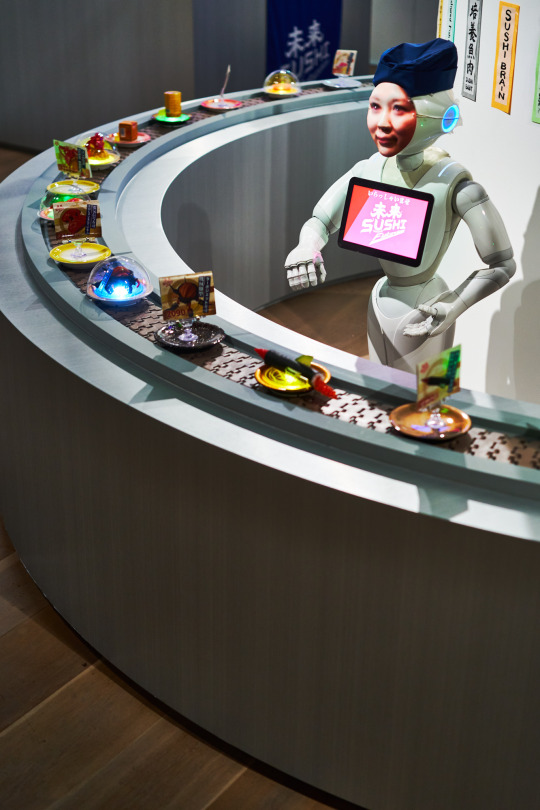
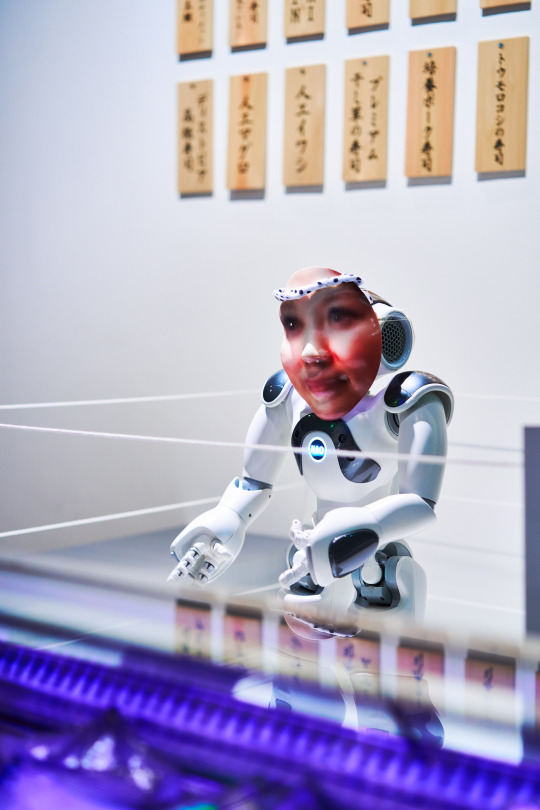
[From Curator's critique by Dr. Lena Fritsch, Ashmolean Museum, Oxford]
Ichihara's use of humanoids, which have also appeared in a number of her past works, mirrors Japan's interest in linking humans or animals with technological objects, often in a light-hearted manner.
I agree with technology researcher Sone Yuji, who has examined Ichihara's works through the lens of Japanese "techno-animism", arguing that there is a strong tradition of animism in Japan: it can be found in a "wide range of phenomena, beliefs, and practices, accounting for a wide range of spirits, gods, ancestors, ghosts, or malevolent monsters. Expanding on this idea of animism, a sense of social agency that blurs distinctions between organic beings and inanimate objects, and between humans and technological things, can also be assigned to the man-made-something that indeed appears to be deeply rooted in Japanese culture. Ichihara's art combining elements of Shintoism, Buddhism, and traditional culture with cutting edge technology represents a distinctively Japanese approach that cultural anthropologist Ann Alison has found in technological toy creations such as the Tamagotchi, defining it as the "animist unconscious".
Hardware

This installation comprises a combination of multiple devices:
[Food Samples]
The future sushi has been recreated using the traditional food sample technique from Japan's food industry. The artist interviewed scientists about future food trends and related scientific technologies, combining this evidence with their imagination to conceive and create future sushi under the policy of "half science, half fantasy." A total of 18 types of sushi were produced.
Here are examples of Future SUSHI.
- 2030 / Cultured Fish Meat SUSHI BABY - A sushi larva being cultured in a petri dish, very popular among citizens. Eating is prohibited since it is a companion sushi.

-2050 / Second Stomach Install Sushi - A sushi that assists gastrointestinal functions of mankind with a degenerated digestive organ.

-2070 / Deep Sea Fish Sushi - As a result of marine resources depletion, deep-sea fish are now served for human consumption. Not so sure about freshness and taste so deep-frying is recommended. Eating it raw is unsafe.

[Sushi Plate devices]
Illuminated sushi plates themed around "Future Sushi" were developed. Magical circles created by laser cutting shine with small LEDs, imagining the sushi appearing in the present day through a portal from the future society. Devices made by 3D printing are embedded in the underside of the plates, powered by Eneloop batteries, and can be switched on and off. The coloring is designed to match the form of each sushi.

[Sushi conveyor]
The sushi conveyor, symbolizing the representation of automation and the relentless flow of time prior to the COVID-19 pandemic, was chosen for its relevance. Using real conveyor chains for sushi ensures stable operation.
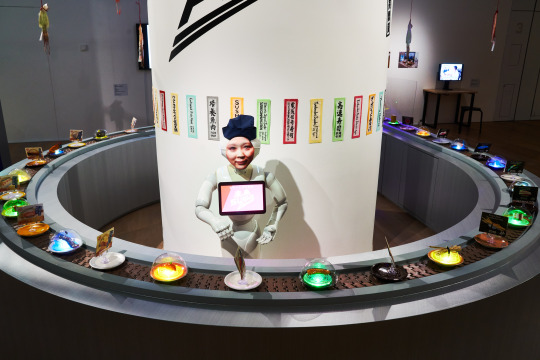
[Magical dystopian security gate] As a boundary marker of the dystopian worldview, a security gate stands at the entrance to Future SUSHI. When humans pass through, it detects "future contraband," causing magical circles to light up randomly. Implemented with Arduino, infrared sensors, and Neopixel, it reacts to human passage through the gate. Only children are exempt from the contraband detection (with an exclusion setting for children's height).



[Other objects of the installation] -Mysterious Sushi Showcase: A showcase that contains replicas of such futuristic ingredients as brains, cultured salmon roe, artificial wasabi, and natural fish aged for 70 years.



-Future SUSHI Price List: A list of future SUSHI prices. The currency is NY (Neo YEN), and prices are estimated to be 100 times the current prices due to inflation. With the note: "Survival tax and oxygen charges are not included.”
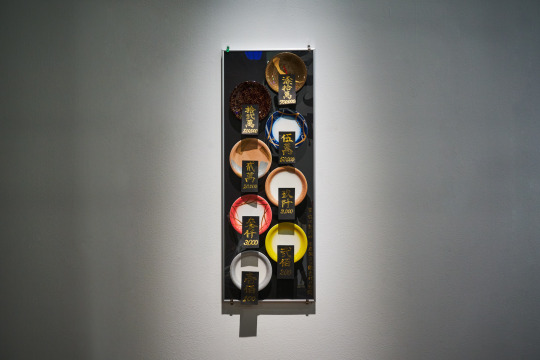
Technical Requirements
[Equipment provided by the artist]
Essentials: - 18 food samples of futuristic sushi - 18 rotating sushi plates - Eneloop batteries (AAA) x20 and a charger
Items to send according to exhibition requirements: - Humanoid robot / Softbank Nao (for overseas exhibitions, a smaller robot will mainly be used) - Robot face masks - Rotating conveyor (for overseas shipping, a lighter and simplified mechanism will be considered; for a previous exhibition in Graz, Austria, a full-scale product conveyor was sourced locally, so using the same fixture might be possible) - LED mechanism for magical circle gate, circular acrylic, Arduino - Other decorative items and equipment can be provided as needed - Note: For a minimum package excluding the robot, shipping costs from Japan to Austria are approximately 450€ (based on previous exhibition experience in Graz). Items can be customized according to budget and exhibition content
[Equipments by Ars Electronica]
- 1 monitor - 1 PC for robot control - 1 display fixture for the robot - Fixture simulating an airport gate - Power supply
[Space requirements]
- A space of 5m x 5m is desirable, ideally with at least one wall - A dimly lit space is preferable for LED visibility
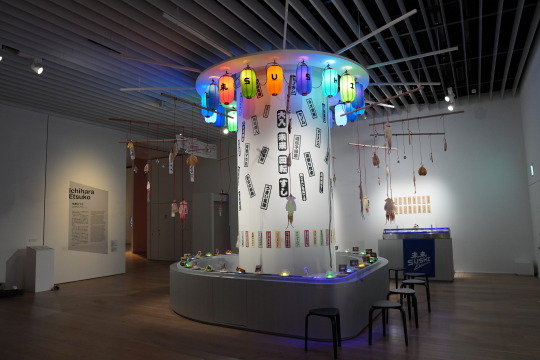
[Required persons and support]
- Having staff familiar with the robot control app (Choregraphe) is desirable; the operation is straightforward and can be performed by anyone - Daily battery replacement for sushi plates is necessary
[Notes]
- The design and content of the exhibition can be flexibly adjusted according to budget and space requirements
0 notes